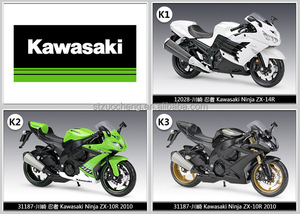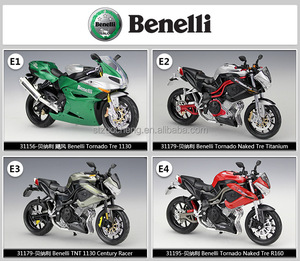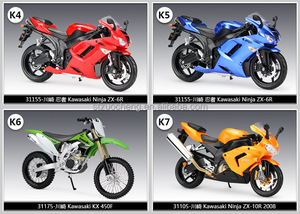
All categories
Featured selections
Trade Assurance
Buyer Central
Help Center
Get the app
Become a supplier

(238 products available)













































There are two main types of 1 3 scale motorcycles:
Electric 1 3 scale motorcycles
The electric 1 3 scale motorcycles have electric motors that are powered by batteries. The batteries are rechargeable, so they can be charged multiple times. These bikes have several advantages over nitro-powered models. They are quieter, so they don't make a lot of noise. They also produce no emissions, so they are better for the environment. Electric bikes are also easier to maintain, and the electric motors can provide instant torque for faster acceleration. However, electric 1 3 scale motorcycles can be more expensive to operate because the batteries and charging equipment cost money. The batteries also need replacing after a certain number of cycles, and they can take a few hours to charge.
Nitro-powered 1 3 scale motorcycles
Nitro-powered 1 3 scale motorcycles use small internal combustion engines to power the bikes. These engines run on nitro fuel, which is a special type of fuel that contains about 10-40% nitromethane. Nitro-powered bikes can be more powerful than electric bikes, making them faster and better for racing. The running time for nitro-powered 1:3 scale motorcycles is longer than for electric bikes because they can continually refuel. Nitro models also have a faster response to the throttle. However, nitro-powered 1 3 scale motorcycles require more maintenance because the engine has more moving parts. The nitro fuel also makes these bikes more expensive to operate than electric models.
Each model motorcycle has specifications that are important to understand.
Size
1-3 scale motorcycles are larger than most model motorcycles. They are about 33% smaller than real-life motorcycles.
Material
Most 1/3 scale motorcycles are made from metal. This is to ensure that the motorcycles are durable and can withstand wear and tear. They also have parts that are made of plastic. The parts made of plastic are used to reduce the overall weight of the motorcycle.
Weight
1/3 scale motorcycles are heavier than other toy vehicles. The weight of the motorcycle models varies depending on the material used and the specific design of the model.
Detailing
1/3 scale motorcycles pay attention to detail. They are designed to look like real-life motorcycles. The level of detail varies depending on the specific model of the motorcycle.
Functionality
Some 1/3 scale motorcycles have functioning features like working lights. Others have wheels that roll. The functionality depends on the model and the manufacturer.
Decoration
1/3 scale motorcycles can be painted in different colors. They can also have decals added to enhance their appearance and make them more attractive. The color and decoration of the scale motorcycle vary depending on the specific model and can be customized to suit different preferences.
1/3 scale motorcycles require maintenance to ensure they keep functioning and looking great. Here are some maintenance tips:
Regular cleaning
It is important to regularly clean the scale motorcycles to get rid of dust and dirt. This will prevent dust accumulation, which can damage the paint and fine details of the motorcycle. Use a soft brush or cloth to clean the dust. A mild detergent solution can be used to wipe off the dirt. Make sure the motorcycle is dry before using it or putting it back on the shelf.
Avoid direct sunlight
Keep the 1/3 scale motorcycles away from direct sunlight. This will prevent the color from fading. Also, avoid places with extreme temperatures or humidity, which can cause damage to the model over time.
Tighten loose parts
With time and regular use, some parts of the motorcycle may become loose. It is important to regularly check the model and tighten any loose parts. This will ensure that the model stays in good condition and prevents any damage that may be caused by loose parts.
Avoid falling
1/3 scale motorcycles are fragile. It is important to keep them away from places where they can fall. This will prevent breakage or damage to the model.
Choosing 1:3 scale motorcycles can be challenging, but with the right tips, it can be easy. Here are some tips:
Consider the theme:
When choosing 1:3 scale motorcycles, it is essential to consider the theme. The theme will guide the type of model to select.
Color:
Color is an important factor to consider when choosing 1:3 scale motorcycles. Choose a color that will fit in the environment.
Type of bike:
There are different types of 1:3 scale motorcycles, such as Harley Davidson and racing motorcycles. Choose the type of bike that suits the taste.
Budget:
Budget is a great consideration when choosing 1:3 scale motorcycles. Different models have different prices, so choose the one that fits the budget.
Here's a general guide on how to repair and maintain 1 3 scale model motorcycles:
Regular Cleaning
Regularly clean the model to prevent dirt and dust accumulation. Use a soft brush or cloth to remove loose dust, and use a mild cleaner or soapy water with a soft cloth to clean it. Avoid using harsh chemicals that could damage the model's finish.
Tighten Loose Parts
Check the model's components regularly to ensure there are no loose parts. If you find any, use a suitable screwdriver or wrench to tighten them gently. Be careful not to use excessive force, as this may damage small or brittle components.
Replace Broken Parts
If any parts are broken or chipped, look for spare parts from the manufacturer or model hobby shops. Replacing broken parts is essential to maintaining the model's original appearance and functionality.
Check and Maintain Tires
If the scale model has rubber tires, check their condition. Ensure there are no cracks or wear signs. If necessary, replace the tires to maintain proper traction and appearance.
Lubrication
Some moving parts, like wheels or swing arms, may require occasional lubrication. Use a suitable lubricant for model vehicles, such as silicone oil or light machine oil, and apply a small amount to the moving parts. This helps maintain smooth movement and reduces wear.
Avoid Direct Sunlight and Extreme Conditions
Keep the scale model in a dry place, away from direct sunlight and extreme temperatures. Prolonged exposure to sunlight can cause fading of the paint and plastic parts, while extreme heat or cold can affect the model's materials.
Storage
If not on display, keep the model in its original box or a dedicated model storage box. This helps protect it from dust, accidental falls, and other potential damage.
Consult the Manual
If the scale model has an instruction manual, refer to it for specific maintenance and repair recommendations. Each model may have different requirements, so the manual is the best source of information.
Q: Can adults ride 1 3 scale motorcycles?
A: While 1 3 scale motorcycles are often designed for children, some models are built for adults. These motorcycles have more powerful engines and larger frames, making them suitable for adult riders.
Q: What is the weight limit for 1 3 scale motorcycles?
A: The weight limit for 1 3 scale motorcycles can vary depending on the specific model and its design features. However, most 1 3 scale motorcycles are designed for children weighing up to 40-50 kg. It's essential to check the manufacturer's recommendations to ensure the motorcycle can safely accommodate the rider's weight.
Q: Are 1 3 scale motorcycles suitable for beginners?
A: Yes, 1 3 scale motorcycles can be suitable for beginners, especially those who are new to riding or have limited experience. These motorcycles offer a smaller and more manageable option, allowing beginners to develop their skills and confidence before transitioning to full-sized motorcycles.